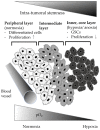A Tumor Suppressor Gene, N-myc Downstream-Regulated Gene 1 (NDRG1), in Gliomas and Glioblastomas
- PMID: 35448004
- PMCID: PMC9029626
- DOI: 10.3390/brainsci12040473
A Tumor Suppressor Gene, N-myc Downstream-Regulated Gene 1 (NDRG1), in Gliomas and Glioblastomas
Abstract
The development of potent and selective therapeutic approaches to glioblastoma (GBM) requires the identification of molecular pathways that critically regulate the survival and proliferation of GBM. Glioblastoma stem-like cells (GSCs) possess stem-cell-like properties, self-renewal, and differentiation into multiple neural cell lineages. From a clinical point of view, GSCs have been reported to resist radiation and chemotherapy. GSCs are influenced by the microenvironment, especially the hypoxic condition. N-myc downstream-regulated gene 1 (NDRG1) is a tumor suppressor with the potential to suppress the proliferation, invasion, and migration of cancer cells. Previous studies have reported that deregulated expression of NDRG1 affects tumor growth and clinical outcomes of patients with GBM. This literature review aimed to clarify the critical role of NDRG1 in tumorigenesis and acquirement of resistance for anti-GBM therapies, further to discussing the possibility and efficacy of NDRG1 as a novel target of treatment for GBM. The present review was conducted by searching the PubMed and Scopus databases. The search was conducted in February 2022. We review current knowledge on the regulation and signaling of NDRG1 in neuro-oncology. Finally, the role of NDRG1 in GBM and potential clinical applications are discussed.
Keywords: N-myc downstream-regulated gene 1; glioblastoma; glioblastoma stem-like cells.
Conflict of interest statement
The authors declare no conflict of interest.
Figures




Similar articles
-
N-myc Downstream-Regulated Gene 1 (NDRG1) Regulates Vascular Endothelial Growth Factor A (VEGFA) and Malignancies in Glioblastoma Multiforme (GBM).Biomed Res Int. 2022 Jun 30;2022:3233004. doi: 10.1155/2022/3233004. eCollection 2022. Biomed Res Int. 2022. Retraction in: Biomed Res Int. 2023 Oct 4;2023:9794063. doi: 10.1155/2023/9794063. PMID: 35813230 Free PMC article. Retracted.
-
Bidirectional Regulation between NDRG1 and GSK3β Controls Tumor Growth and Is Targeted by Differentiation Inducing Factor-1 in Glioblastoma.Cancer Res. 2020 Jan 15;80(2):234-248. doi: 10.1158/0008-5472.CAN-19-0438. Epub 2019 Nov 13. Cancer Res. 2020. PMID: 31723002
-
The proneural gene ASCL1 governs the transcriptional subgroup affiliation in glioblastoma stem cells by directly repressing the mesenchymal gene NDRG1.Cell Death Differ. 2019 Sep;26(9):1813-1831. doi: 10.1038/s41418-018-0248-7. Epub 2018 Dec 11. Cell Death Differ. 2019. PMID: 30538287 Free PMC article.
-
Pharmacological targeting and the diverse functions of the metastasis suppressor, NDRG1, in cancer.Free Radic Biol Med. 2020 Sep;157:154-175. doi: 10.1016/j.freeradbiomed.2019.05.020. Epub 2019 May 24. Free Radic Biol Med. 2020. PMID: 31132412 Review.
-
N-myc Downstream-Regulated Gene 1 and Endometriosis: A Minireview.Crit Rev Eukaryot Gene Expr. 2017;27(4):341-345. doi: 10.1615/CritRevEukaryotGeneExpr.2017020516. Crit Rev Eukaryot Gene Expr. 2017. PMID: 29283328 Review.
Cited by
-
Ligustilide Inhibits the PI3K/AKT Signalling Pathway and Suppresses Cholangiocarcinoma Cell Proliferation, Migration, and Invasion.Recent Pat Anticancer Drug Discov. 2025;20(2):200-212. doi: 10.2174/0115748928332384240812060751. Recent Pat Anticancer Drug Discov. 2025. PMID: 39171465
-
A cellular senescence-related genes model allows for prognosis and treatment stratification of hepatocellular carcinoma: A bioinformatics analysis and experimental verification.Front Genet. 2023 Jan 12;13:1099148. doi: 10.3389/fgene.2022.1099148. eCollection 2022. Front Genet. 2023. PMID: 36712870 Free PMC article.
-
N-myc Downstream-Regulated Gene 1 (NDRG1) Regulates Vascular Endothelial Growth Factor A (VEGFA) and Malignancies in Glioblastoma Multiforme (GBM).Biomed Res Int. 2022 Jun 30;2022:3233004. doi: 10.1155/2022/3233004. eCollection 2022. Biomed Res Int. 2022. Retraction in: Biomed Res Int. 2023 Oct 4;2023:9794063. doi: 10.1155/2023/9794063. PMID: 35813230 Free PMC article. Retracted.
-
Unveiling the role of Ndrg1 gene on the oxidative stress induction behind the anticancer potential of styrylquinazoline derivatives.Sci Rep. 2025 May 8;15(1):16081. doi: 10.1038/s41598-025-99277-1. Sci Rep. 2025. PMID: 40341822 Free PMC article.
References
Publication types
LinkOut - more resources
Full Text Sources

